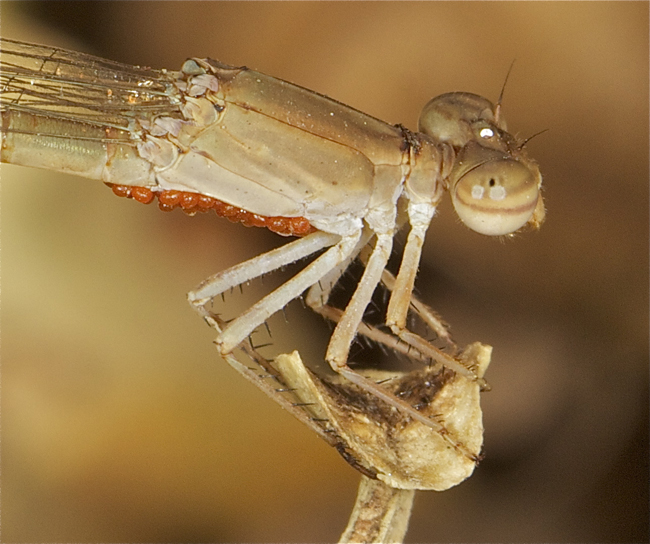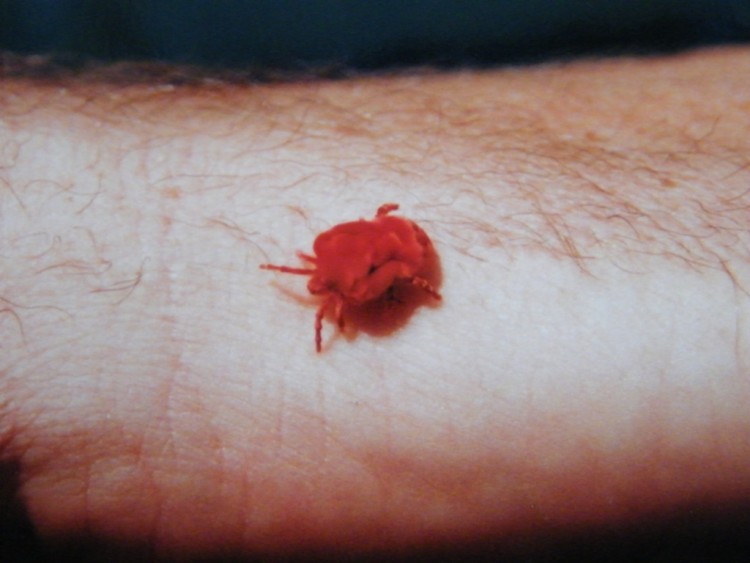Water Mites
Freshwater biologists frequently encounter tiny, brightly coloured creatures scooting busily around ponds and vleis. These are the water mites.
While most mites, which form the arachnid order Acarina, are very common in terrestrial ecosystems, the suborder Trombidiformes (which includes many species of plant parasites) includes a few families that live exclusively in freshwaters. Together these forms are commonly known as the hydracarines.
Links:
https://books.google.de/books?id=ktS4DQ ... ca&f=false
AW Arachnid Book: Parasitengona (Velvet Mites & Water Mites)
Moderator: Klipspringer
-
Klipspringer
- Global Moderator
- Posts: 5862
- Joined: Sat Sep 14, 2013 12:34 pm
- Country: Germany
- Contact:
-
Klipspringer
- Global Moderator
- Posts: 5862
- Joined: Sat Sep 14, 2013 12:34 pm
- Country: Germany
- Contact:
Re: AW Arachnid Book: Parasitengona (Velvet Mites & Water Mites)
Red Water Mite Arrenurus sp
Family Arrenuridae
 © ExFmem
© ExFmem
Larvae on newly emerged female Common Citril damselfly, Kruger National Park
Ectoparasitic mites are a common and widespread parasite in freshwater, and are associated with nearly all aquatic insects. The most conspicuous and prevalent aquatic ectoparasitic mites affecting Odonata are the Hydrachnidia (= Hydrachnellae, = Hydracarina), or water mites. Among the hydrachnids, Arrenuridae is the main family parasitic on Odonata.
Their larvae actively seek out and crawl to adult Odonata within range. The Arrenuridae life cycle usually involves both a free-living and a parasitic stage. The egg, laid underwater, hatches and releases a hexapod larva which swims freely. This larva then seeks out a final instar host larva and attaches phoretically. During emergence, the mite larvae utilize a vulnerable stage during which it transfers to the teneral Odonate and stays attached as an ectoparasite, feeding on the host’s body fluids. Eventually the hexapod larva drops away from the host into water and moults into the first resting stage, the nymphochrysalis. An additional moult soon after, releases the octopod larva, which is an active subaquatic predator of microcrustacea. After a second resting stage, the teliochrysalis, it is followed by another moult, and the reproductive adult emerges and the life cycle continues.
Arrenurus goes through seven stages - egg, inactive prelarva, larva, protonymph, deutonymph, tritonymph, and adult, only the larval stage being parasitic. Arrenurus larvae are ectoparasites of some aquatic insects in freshwater habitats, particularly the Odonata (Dragonflies and Damselflies). These mites establish an association for the purpose of transportation and nutrients, and attach to the host during the host's transition from larva to adult.

Why are water mites red?
The red colouration probably came from a common ancestor of water mites and velvet mites. The carotenoid (as in carrots) pigments that produce the red colour can help protect mites from ultraviolet radiation - essentially acting as a sunscreen. But red is also highly visible to animals with colour vision and is often associated with being distasteful or poisonous. Apparently, many water mites do make fish want to gag and they quickly spit them out and learn to avoid them in the future.
Links:
https://www.ru.ac.za/media/rhodesuniver ... rachnellae
Family Arrenuridae
Larvae on newly emerged female Common Citril damselfly, Kruger National Park
Ectoparasitic mites are a common and widespread parasite in freshwater, and are associated with nearly all aquatic insects. The most conspicuous and prevalent aquatic ectoparasitic mites affecting Odonata are the Hydrachnidia (= Hydrachnellae, = Hydracarina), or water mites. Among the hydrachnids, Arrenuridae is the main family parasitic on Odonata.
Their larvae actively seek out and crawl to adult Odonata within range. The Arrenuridae life cycle usually involves both a free-living and a parasitic stage. The egg, laid underwater, hatches and releases a hexapod larva which swims freely. This larva then seeks out a final instar host larva and attaches phoretically. During emergence, the mite larvae utilize a vulnerable stage during which it transfers to the teneral Odonate and stays attached as an ectoparasite, feeding on the host’s body fluids. Eventually the hexapod larva drops away from the host into water and moults into the first resting stage, the nymphochrysalis. An additional moult soon after, releases the octopod larva, which is an active subaquatic predator of microcrustacea. After a second resting stage, the teliochrysalis, it is followed by another moult, and the reproductive adult emerges and the life cycle continues.
Arrenurus goes through seven stages - egg, inactive prelarva, larva, protonymph, deutonymph, tritonymph, and adult, only the larval stage being parasitic. Arrenurus larvae are ectoparasites of some aquatic insects in freshwater habitats, particularly the Odonata (Dragonflies and Damselflies). These mites establish an association for the purpose of transportation and nutrients, and attach to the host during the host's transition from larva to adult.

Why are water mites red?
The red colouration probably came from a common ancestor of water mites and velvet mites. The carotenoid (as in carrots) pigments that produce the red colour can help protect mites from ultraviolet radiation - essentially acting as a sunscreen. But red is also highly visible to animals with colour vision and is often associated with being distasteful or poisonous. Apparently, many water mites do make fish want to gag and they quickly spit them out and learn to avoid them in the future.
Links:
https://www.ru.ac.za/media/rhodesuniver ... rachnellae
-
Klipspringer
- Global Moderator
- Posts: 5862
- Joined: Sat Sep 14, 2013 12:34 pm
- Country: Germany
- Contact:
Re: AW Arachnid Book: Parasitengona (Velvet Mites & Water Mites)
Giant Red Velvet Mite Dinothrombium sp.
Family: Trombidiidae
 © nan
© nan
Kgalagadi Transfrontier Park, South Africa
Mites are arachnids in the order Acari, along with the ticks. There are over 30,000 species of mites, and perhaps thousands more to be discovered. Mites have many lifestyles: some are parasitic, some are scavengers, some are predators and still others are herbivores.
The brightly red-orange coloured adults of the genus Dinothrombium are among the largest known mites, with some individuals of the African species exceeding 12 mm in length. The giant velvet mite is covered with a thick red coat of scarlet hair-like setae. The adults have eight legs but the young hatchlings emerge with six legs, not eight.
They are found in sandy desert areas, in soil, and in soil litter habitats around the world. Adult velvet mites spend most of their lives in subterranean burrows in a diapause-like state waiting for a specific set of ecological conditions triggered by summer rains. On desert soils, adults only emerge to the surface of the sand after heavy rain, and may only forage for a few hours per year.
These mites have a rather complex life cycle, with pre-larval and larval stages, three nymphal stages (protonymph, deutonymph, and tritonymph) and then adult males and females. The prelarvae, protonymphs, and tritonymphs are calyptostatic, meaning that they are inactive. The larvae are ectoparasitic on other arthropods. Red velvet mite larvae in the genus Dinothrombium have been found on insects in the order Orthroptera (grasshoppers), Coleoptera (beetles), Lepidoptera (moths and butterflies), and on spiders and sun spiders. The deutonymphs and adults are free-living predators of small arthropods and their eggs.
Complex mating behaviors have been described for a few species of these beautiful arachnids. The male and female mites do encircling dances, during which pair-dance signaling threads are deposited. In at least one species, the dancing pair tap each other with their first pair of legs. Sperm transfer is indirect, with the male depositing a spermatophore that is then picked up by the female. The male may deposit his sperm (spermatophore) on elevated surfaces such as twigs or stalks. One author describes these areas as love gardens. The male will deposit an intricate trail of silk leading to the sperm. The female lays her eggs in masses in the soil or sand. The number of eggs laid varies with the species. One species of Dinothrombium (D. tinctorium) lays 100,000 eggs.
 © Richprins
© Richprins
SE Botswana
Family: Trombidiidae
Kgalagadi Transfrontier Park, South Africa
Mites are arachnids in the order Acari, along with the ticks. There are over 30,000 species of mites, and perhaps thousands more to be discovered. Mites have many lifestyles: some are parasitic, some are scavengers, some are predators and still others are herbivores.
The brightly red-orange coloured adults of the genus Dinothrombium are among the largest known mites, with some individuals of the African species exceeding 12 mm in length. The giant velvet mite is covered with a thick red coat of scarlet hair-like setae. The adults have eight legs but the young hatchlings emerge with six legs, not eight.
They are found in sandy desert areas, in soil, and in soil litter habitats around the world. Adult velvet mites spend most of their lives in subterranean burrows in a diapause-like state waiting for a specific set of ecological conditions triggered by summer rains. On desert soils, adults only emerge to the surface of the sand after heavy rain, and may only forage for a few hours per year.
These mites have a rather complex life cycle, with pre-larval and larval stages, three nymphal stages (protonymph, deutonymph, and tritonymph) and then adult males and females. The prelarvae, protonymphs, and tritonymphs are calyptostatic, meaning that they are inactive. The larvae are ectoparasitic on other arthropods. Red velvet mite larvae in the genus Dinothrombium have been found on insects in the order Orthroptera (grasshoppers), Coleoptera (beetles), Lepidoptera (moths and butterflies), and on spiders and sun spiders. The deutonymphs and adults are free-living predators of small arthropods and their eggs.
Complex mating behaviors have been described for a few species of these beautiful arachnids. The male and female mites do encircling dances, during which pair-dance signaling threads are deposited. In at least one species, the dancing pair tap each other with their first pair of legs. Sperm transfer is indirect, with the male depositing a spermatophore that is then picked up by the female. The male may deposit his sperm (spermatophore) on elevated surfaces such as twigs or stalks. One author describes these areas as love gardens. The male will deposit an intricate trail of silk leading to the sperm. The female lays her eggs in masses in the soil or sand. The number of eggs laid varies with the species. One species of Dinothrombium (D. tinctorium) lays 100,000 eggs.
SE Botswana


